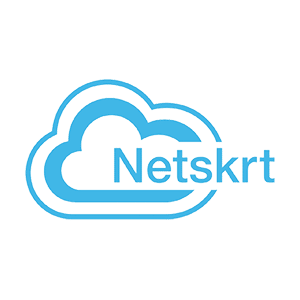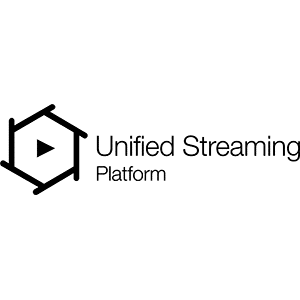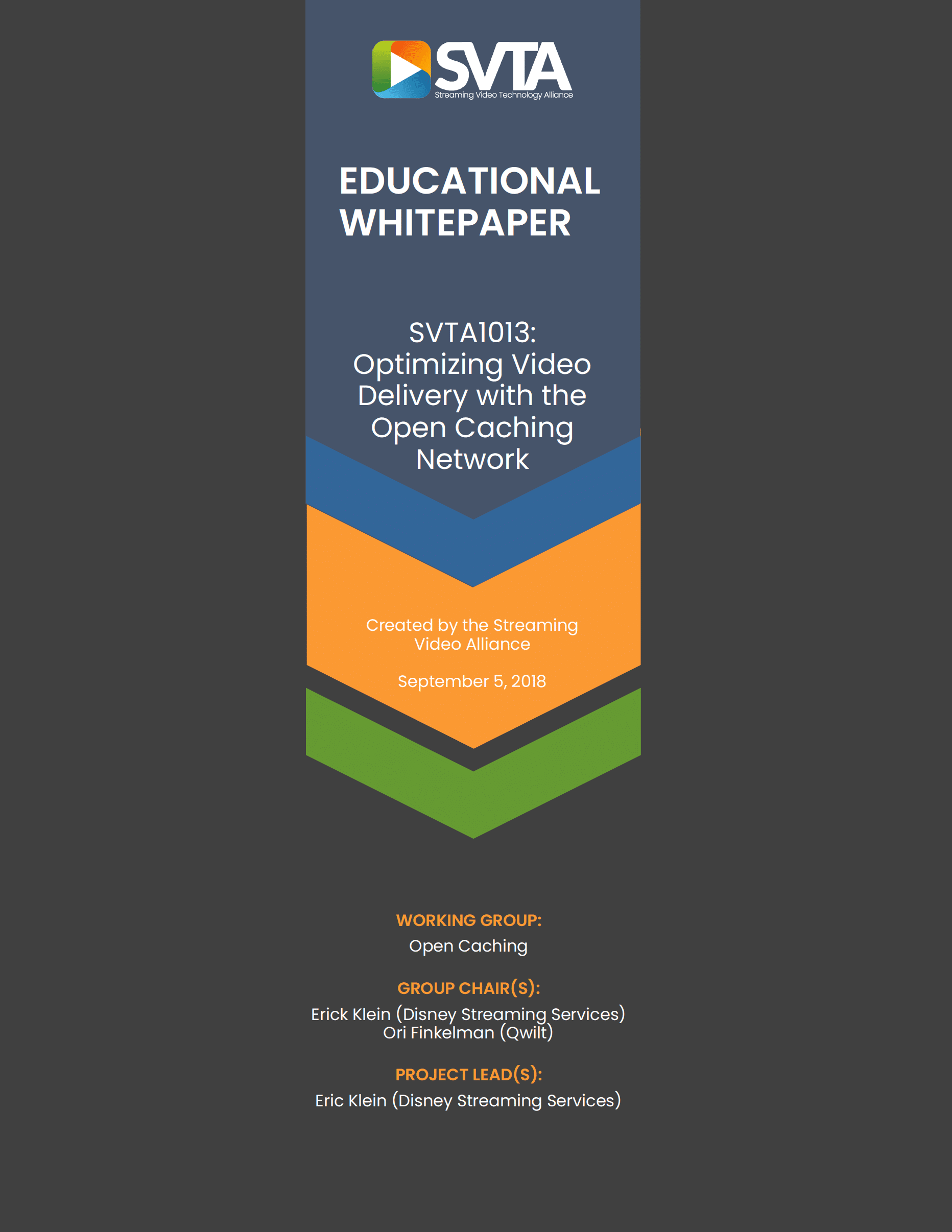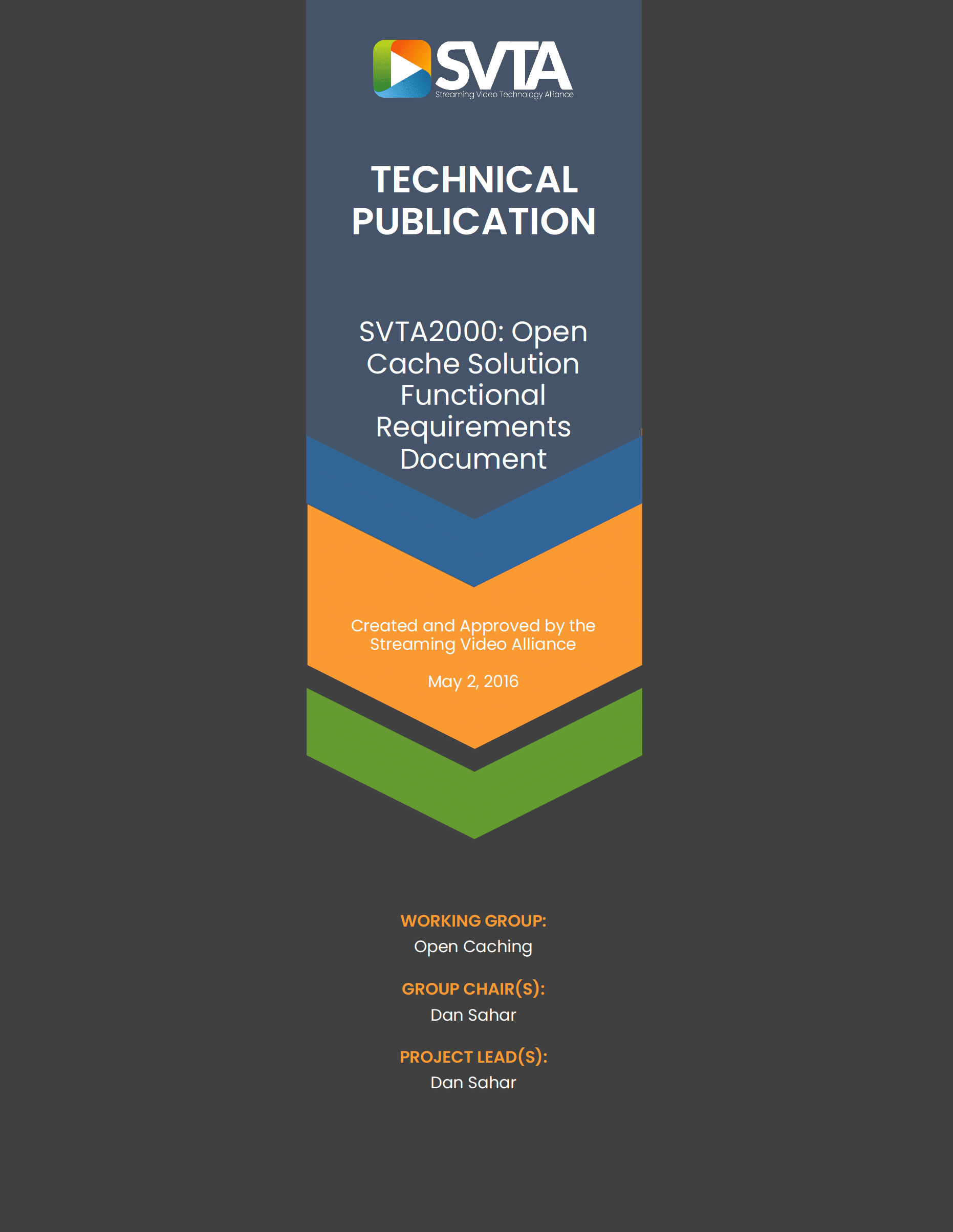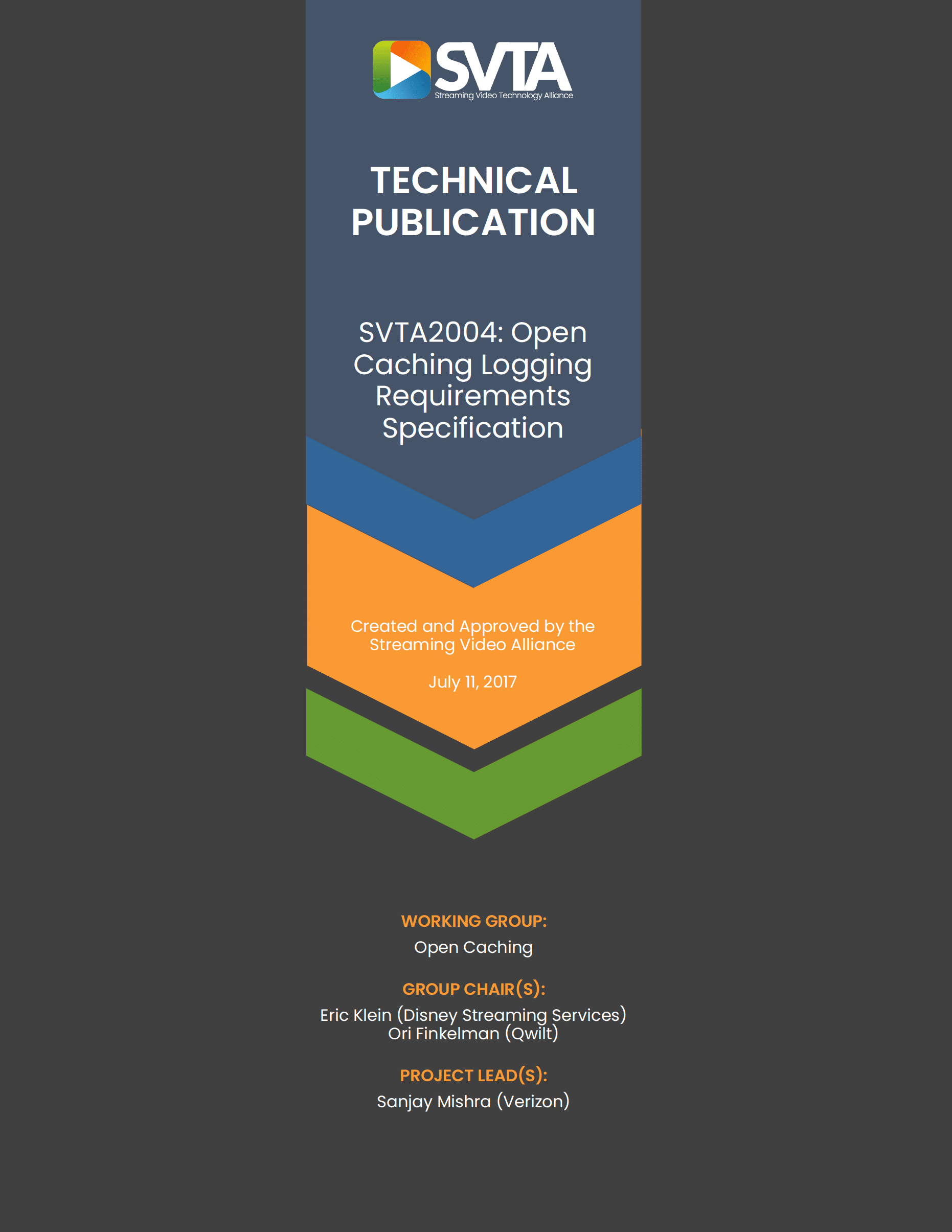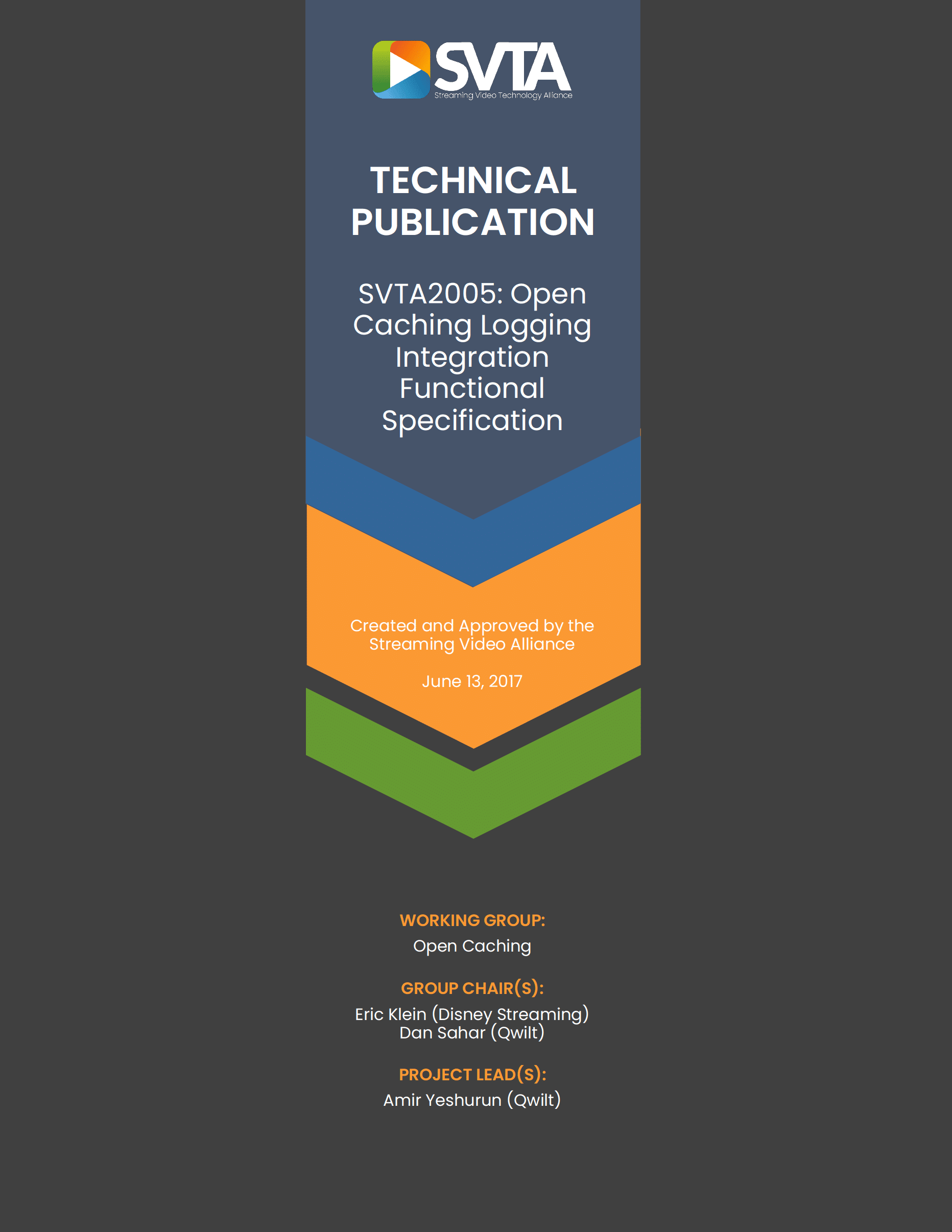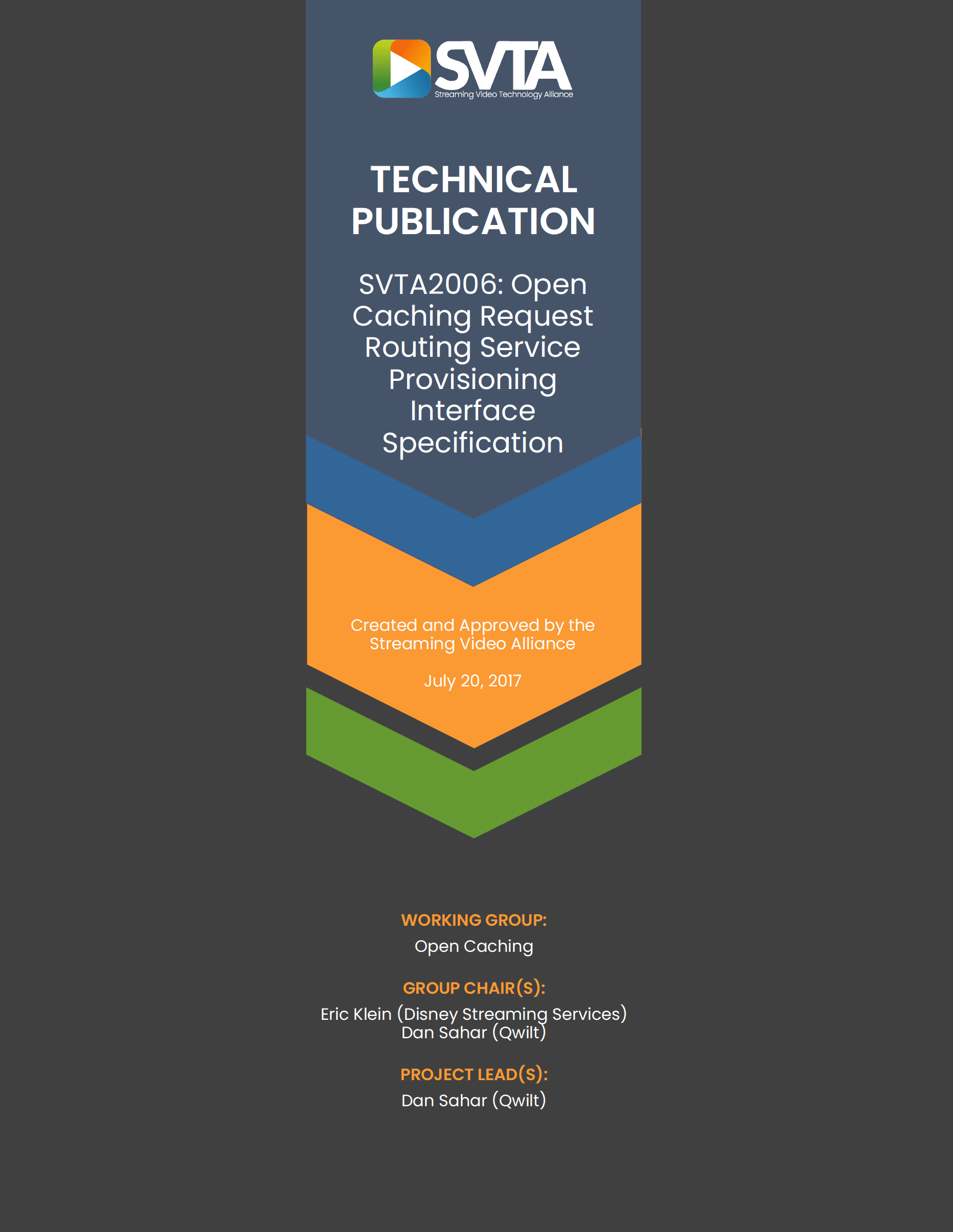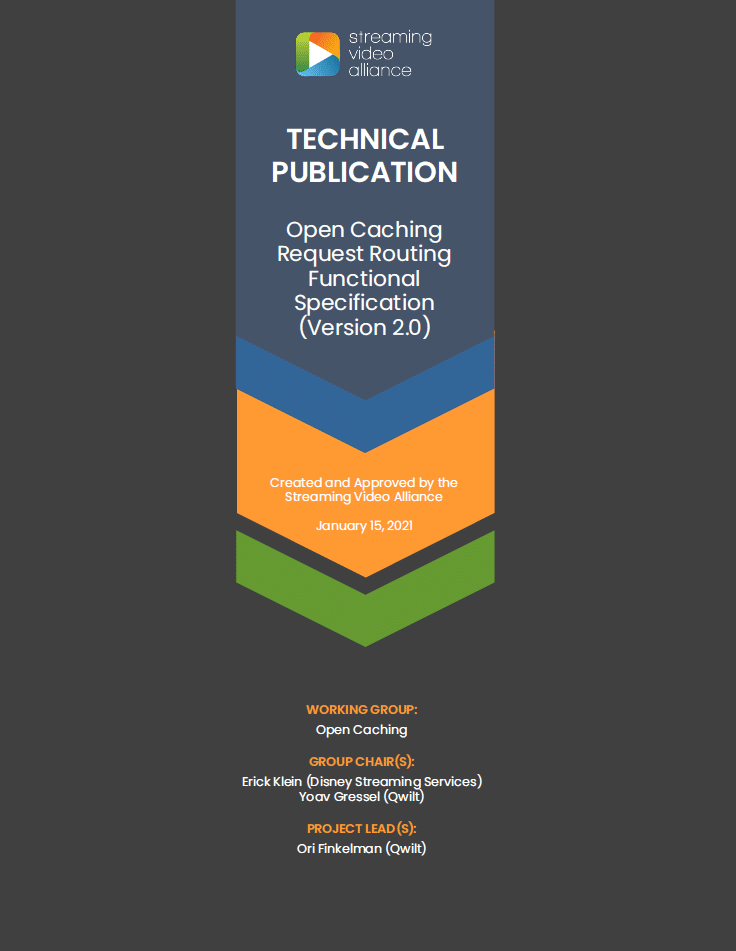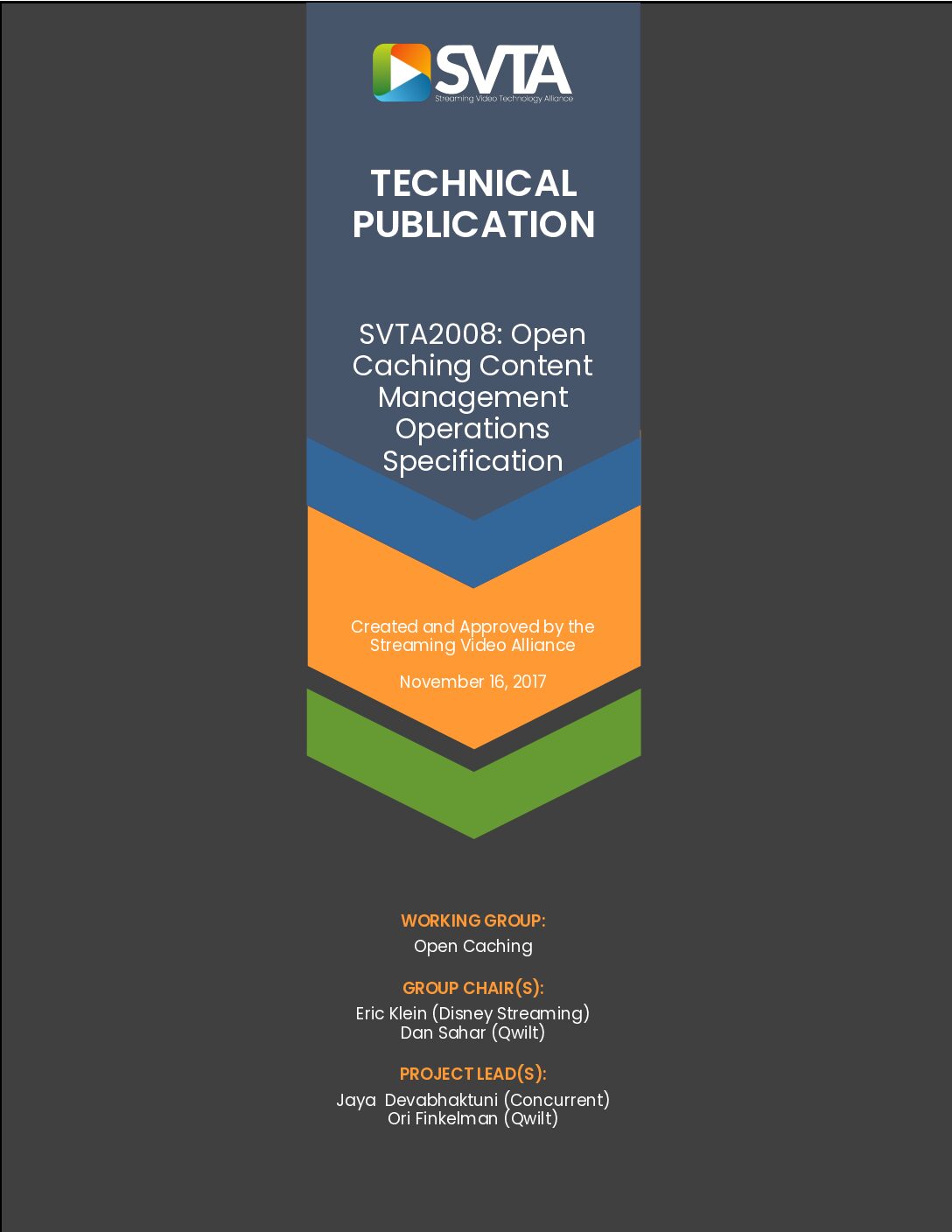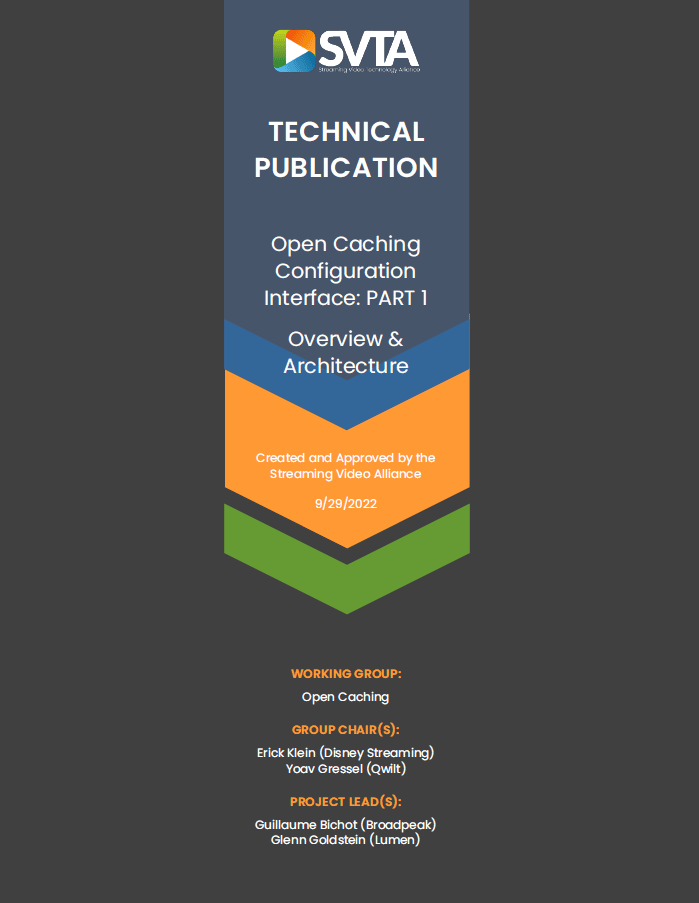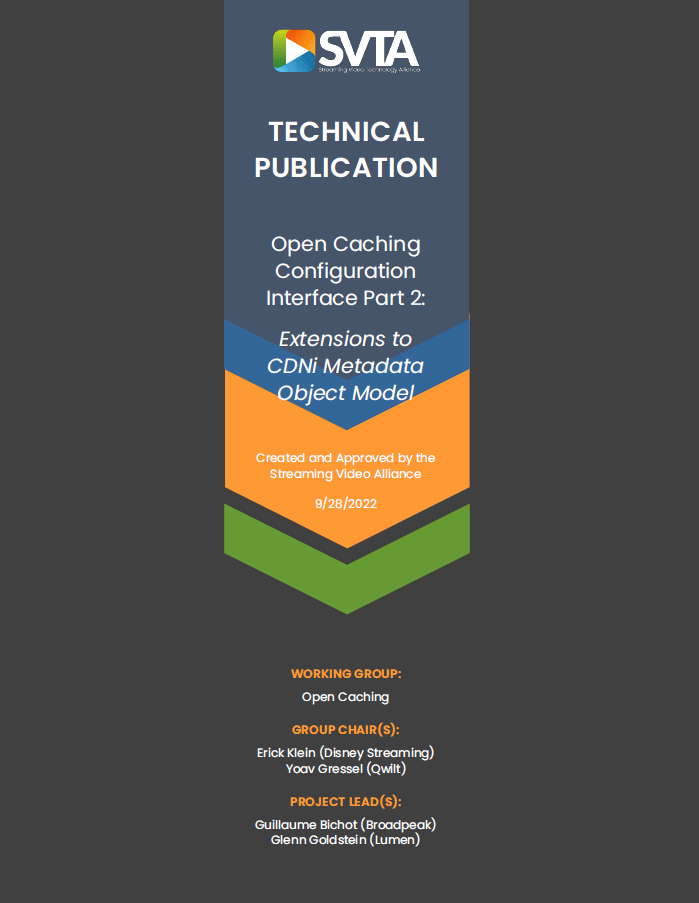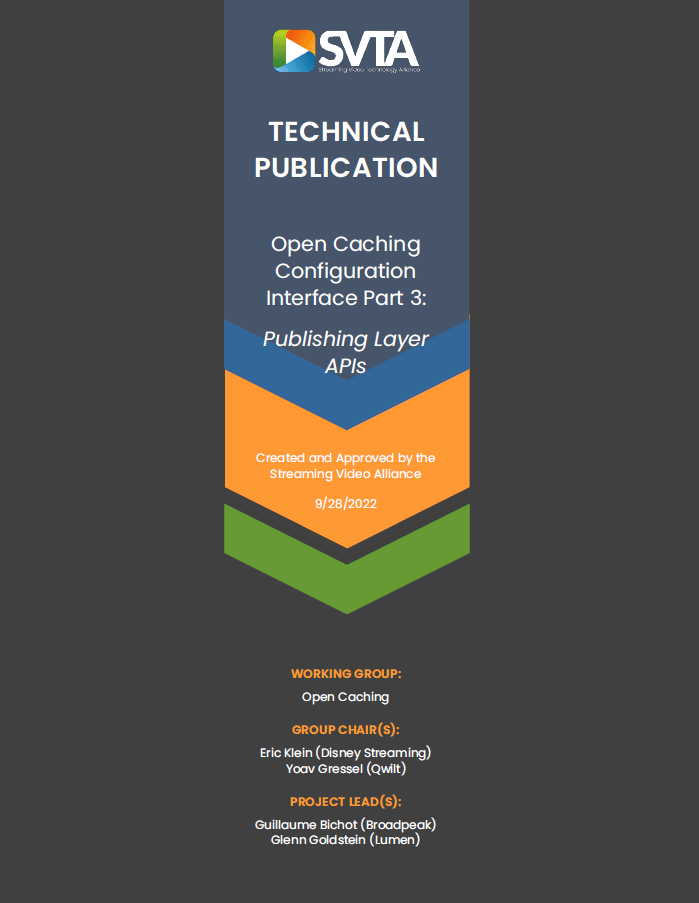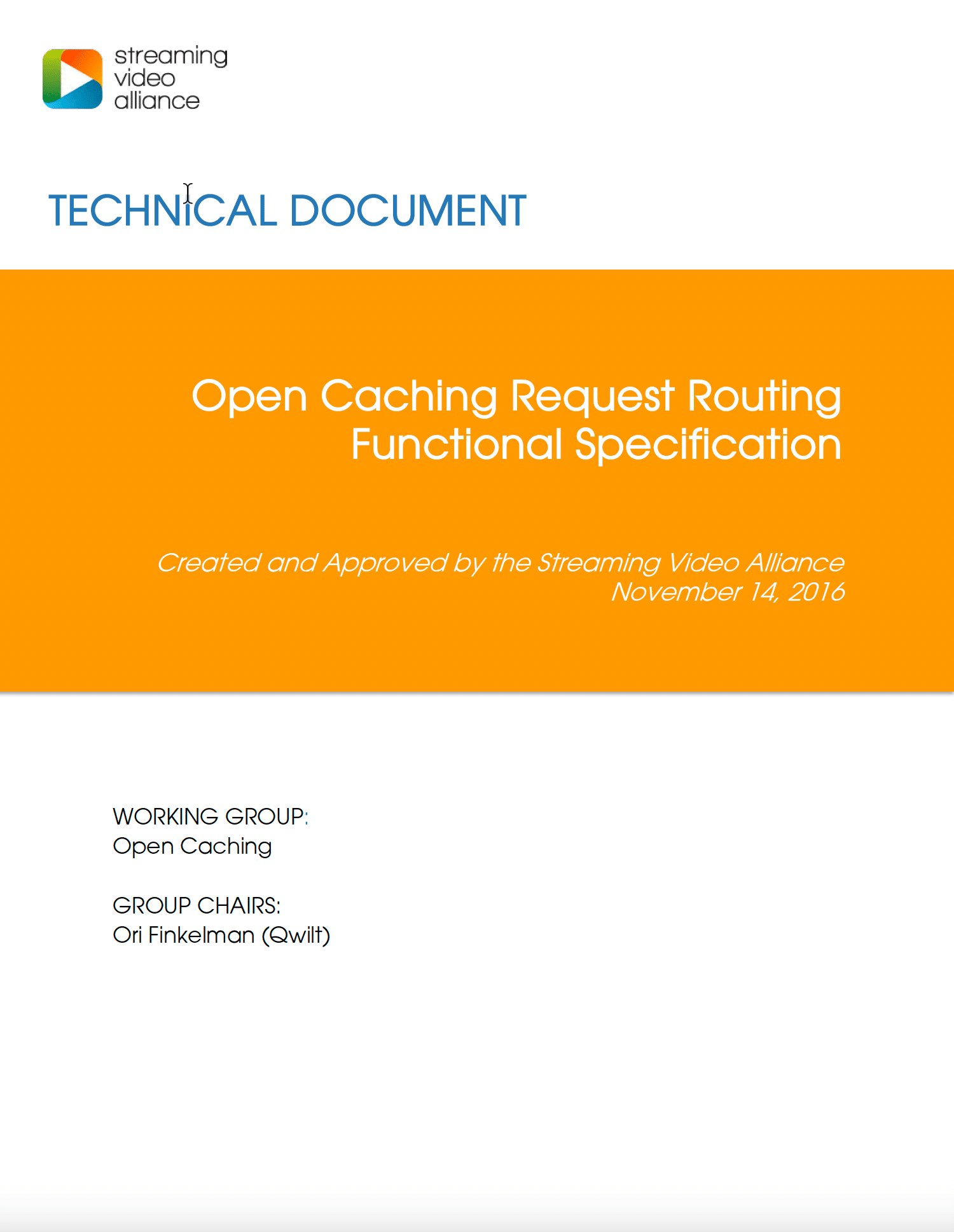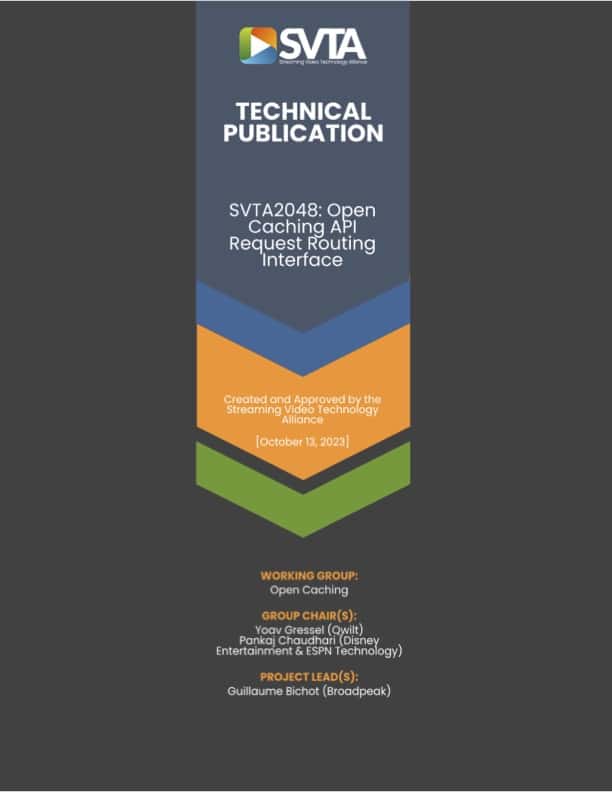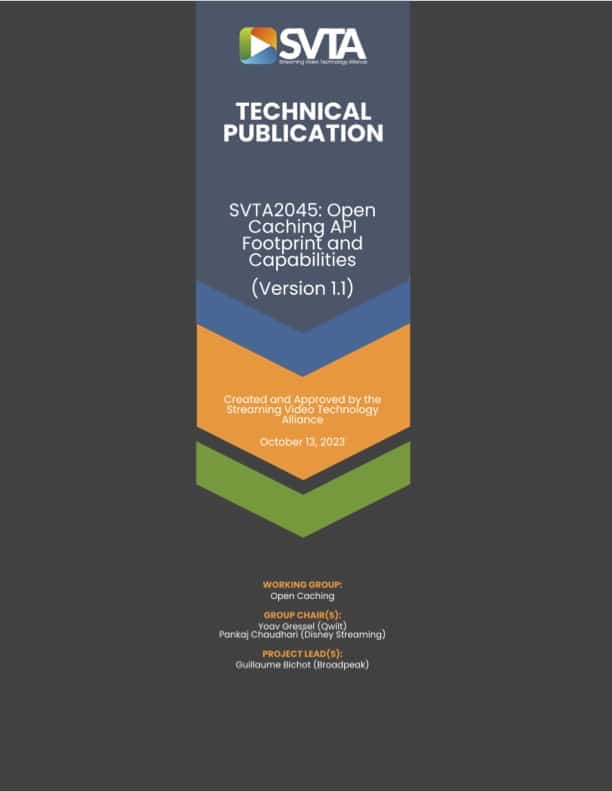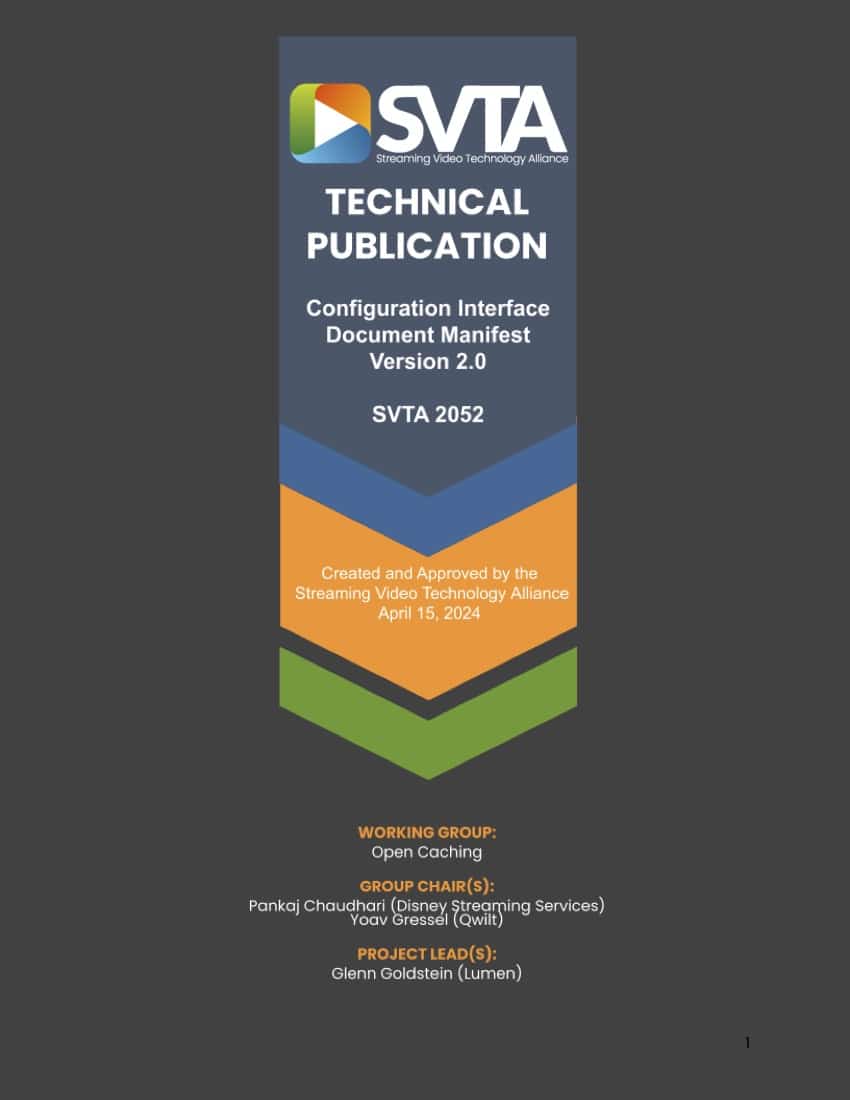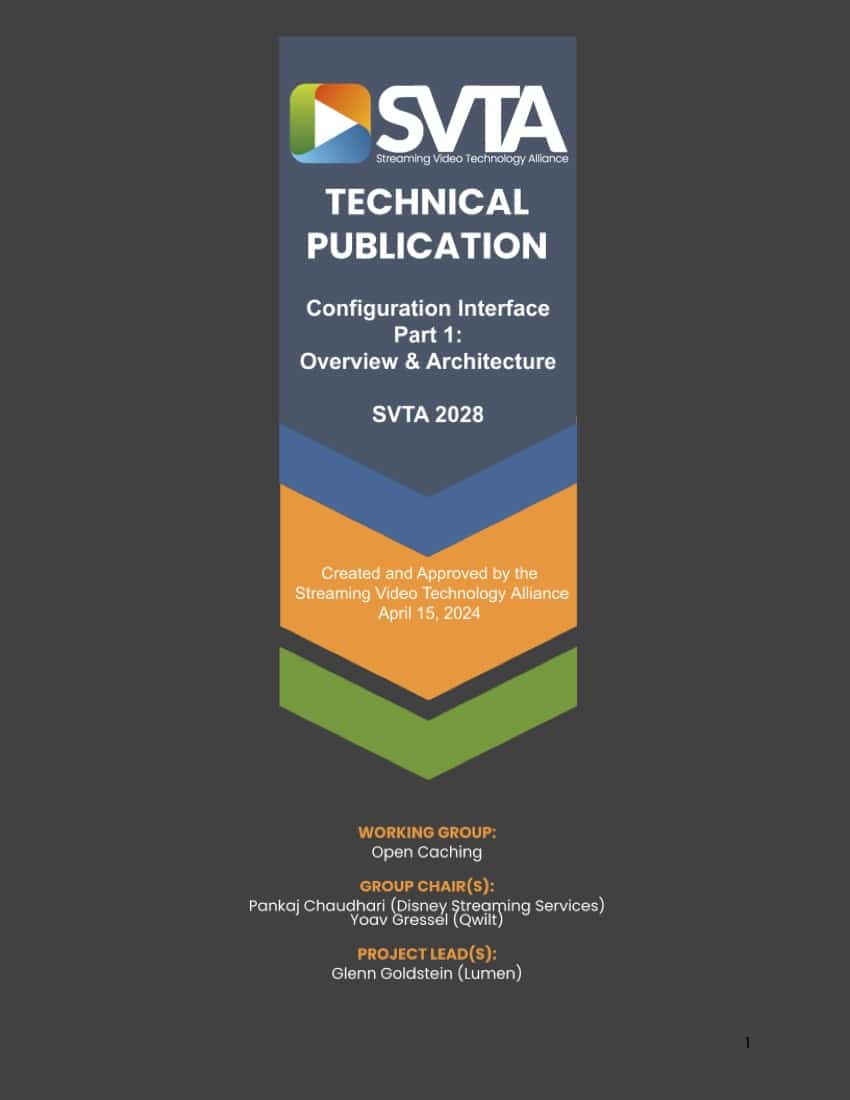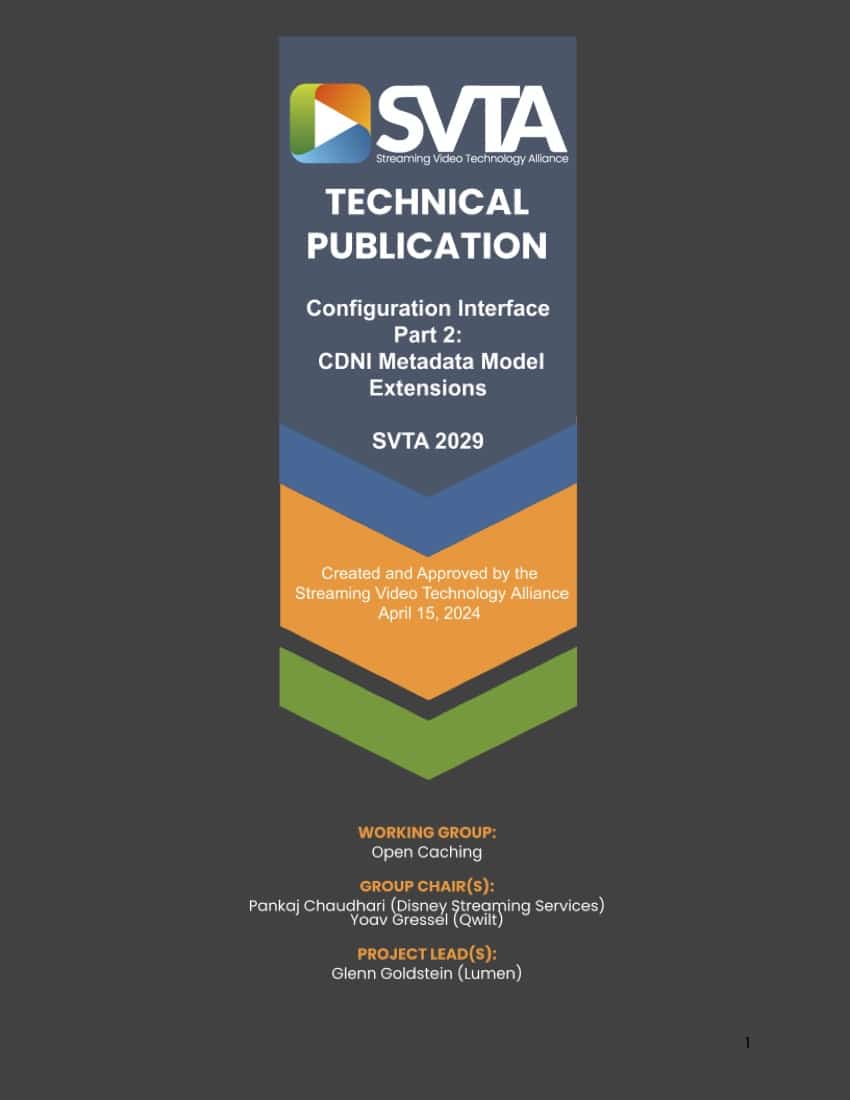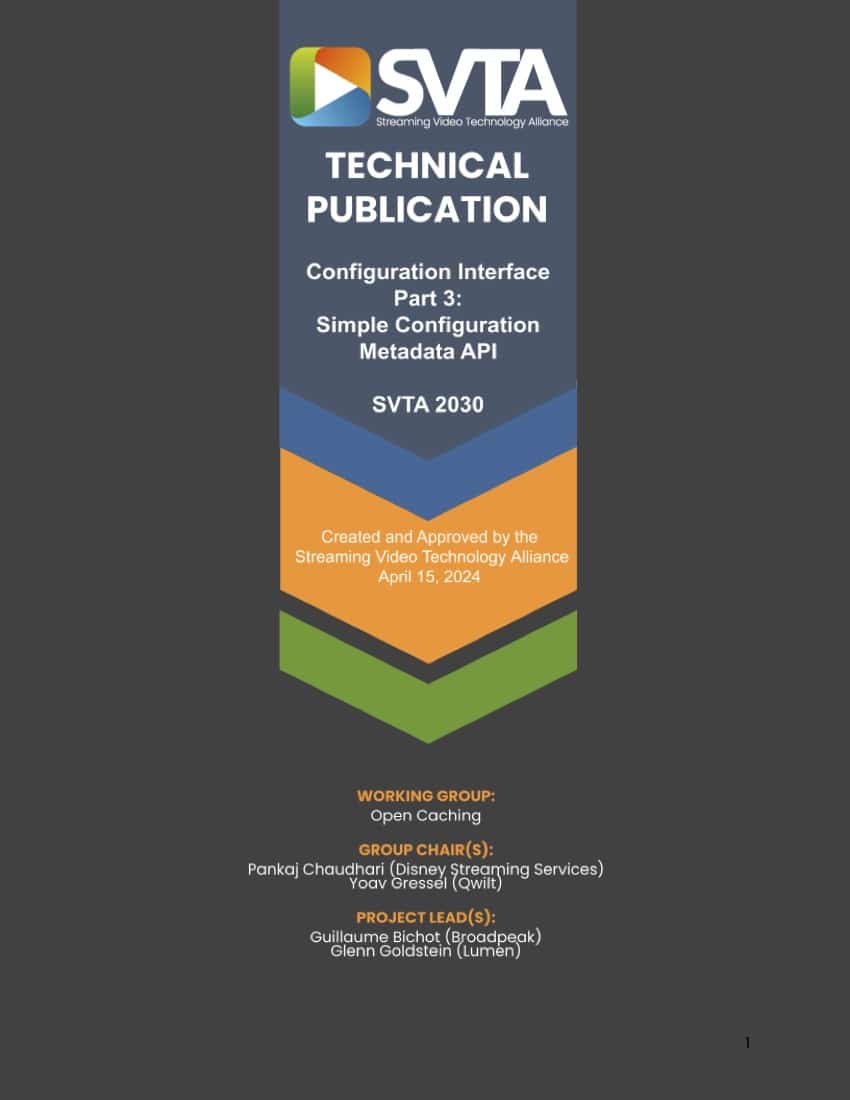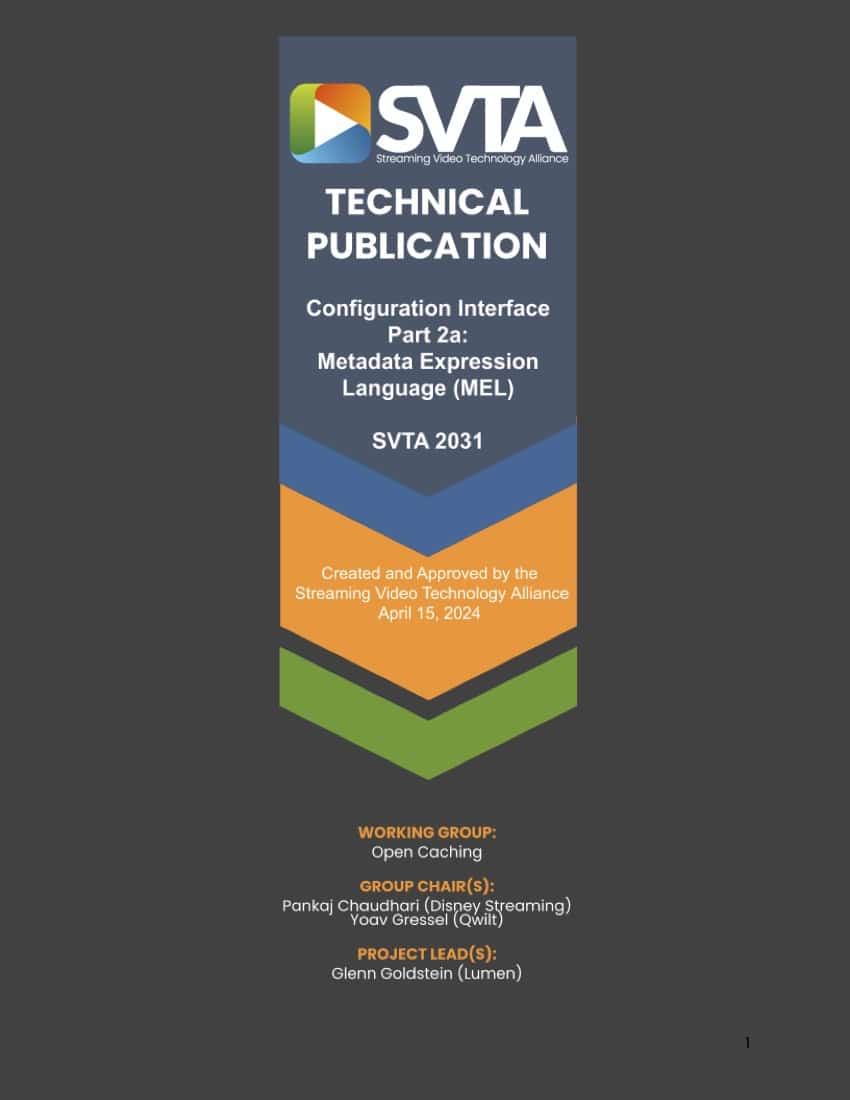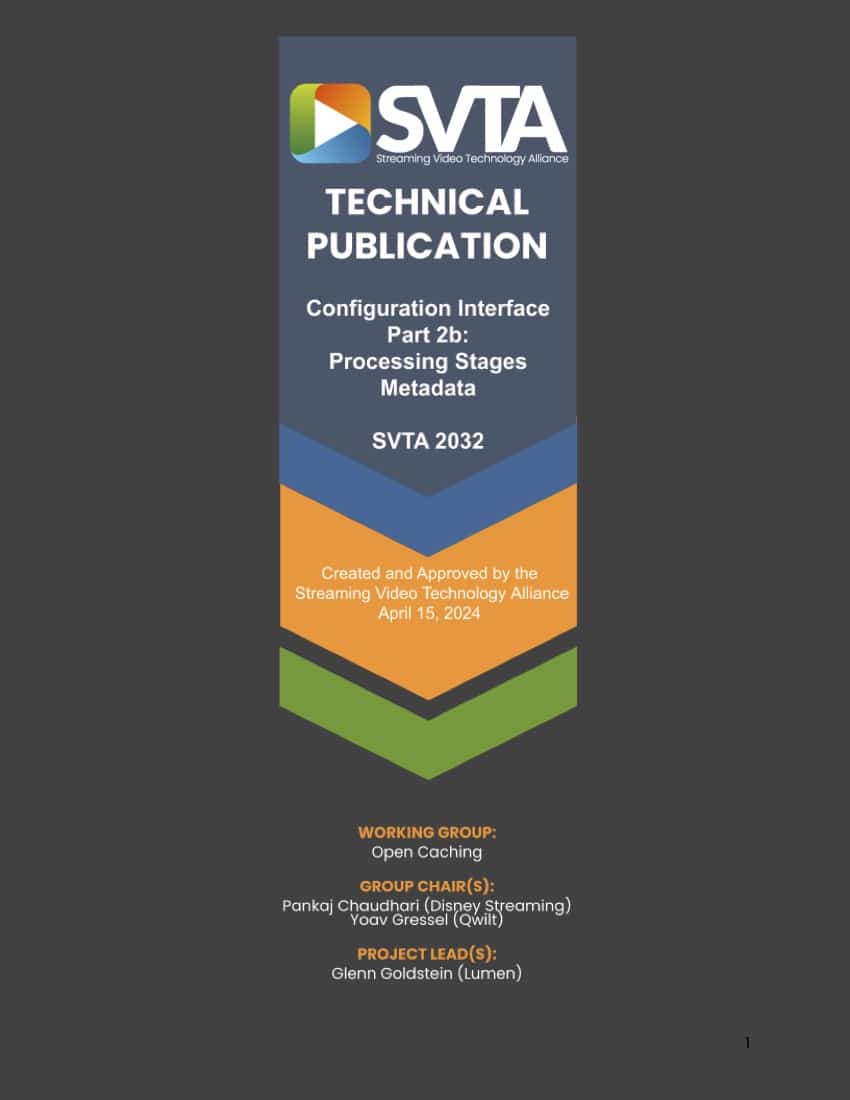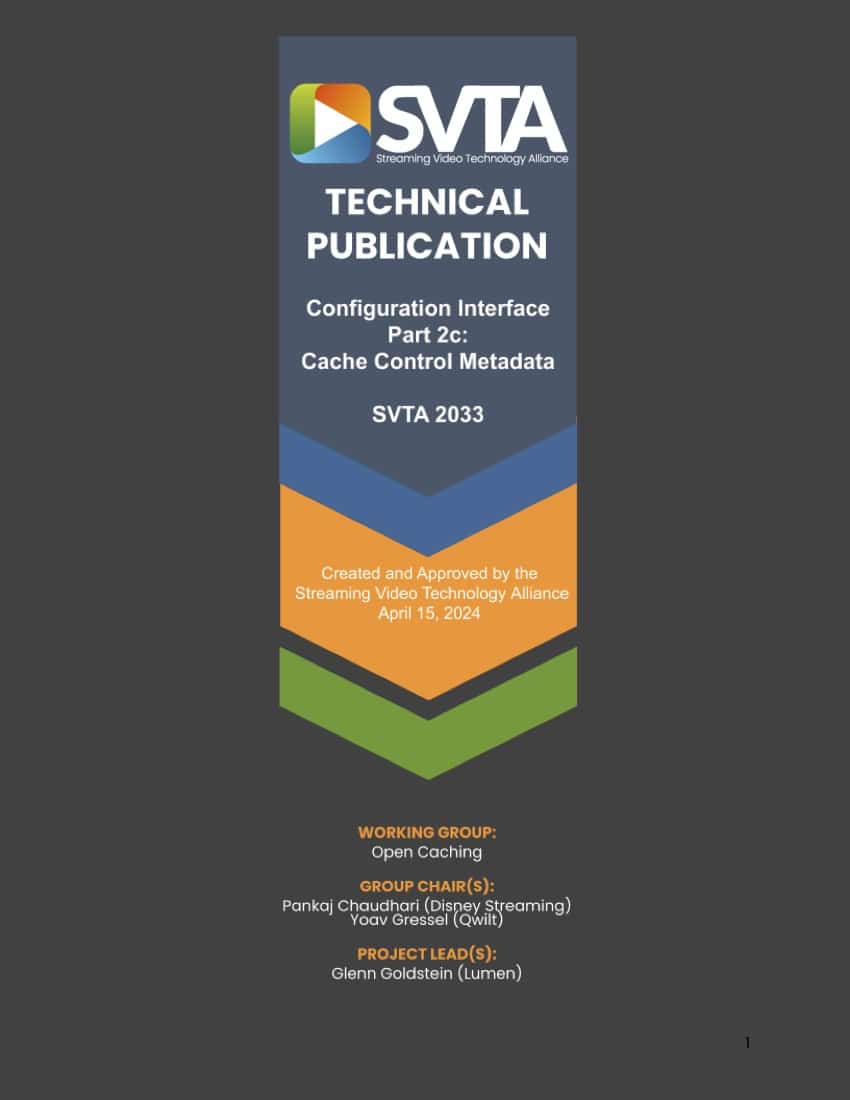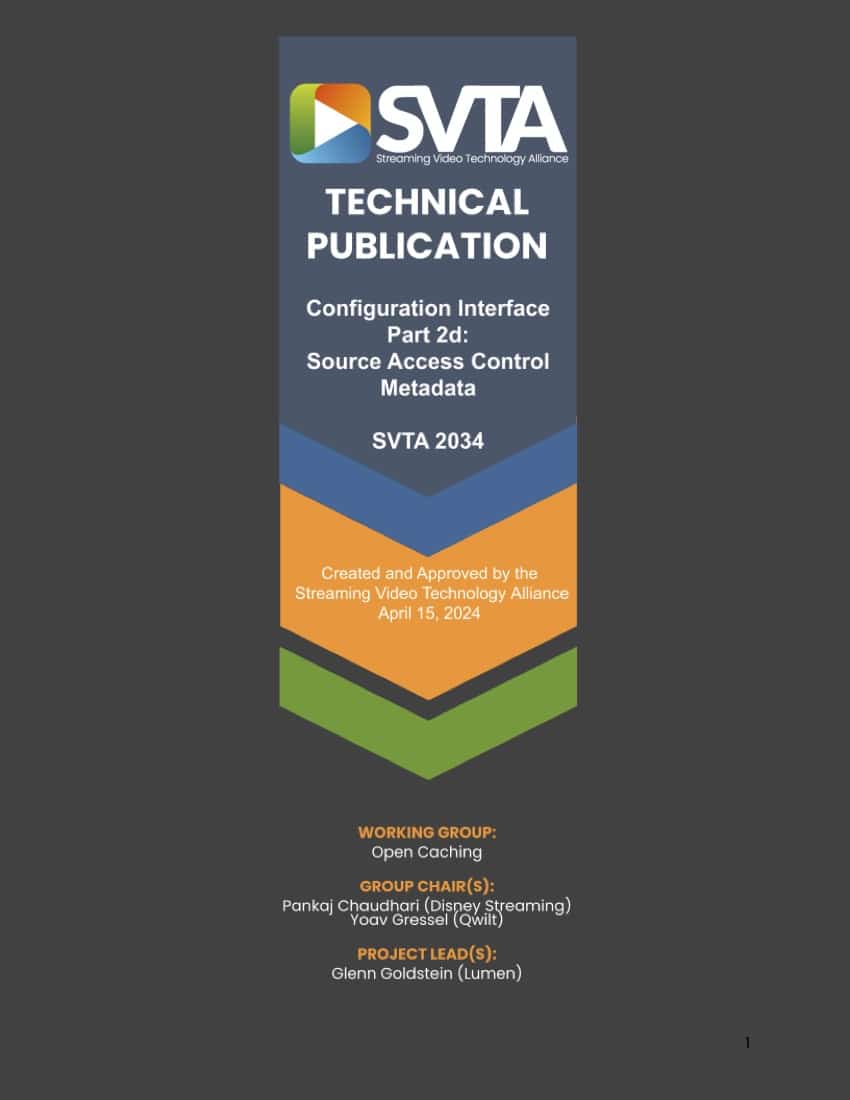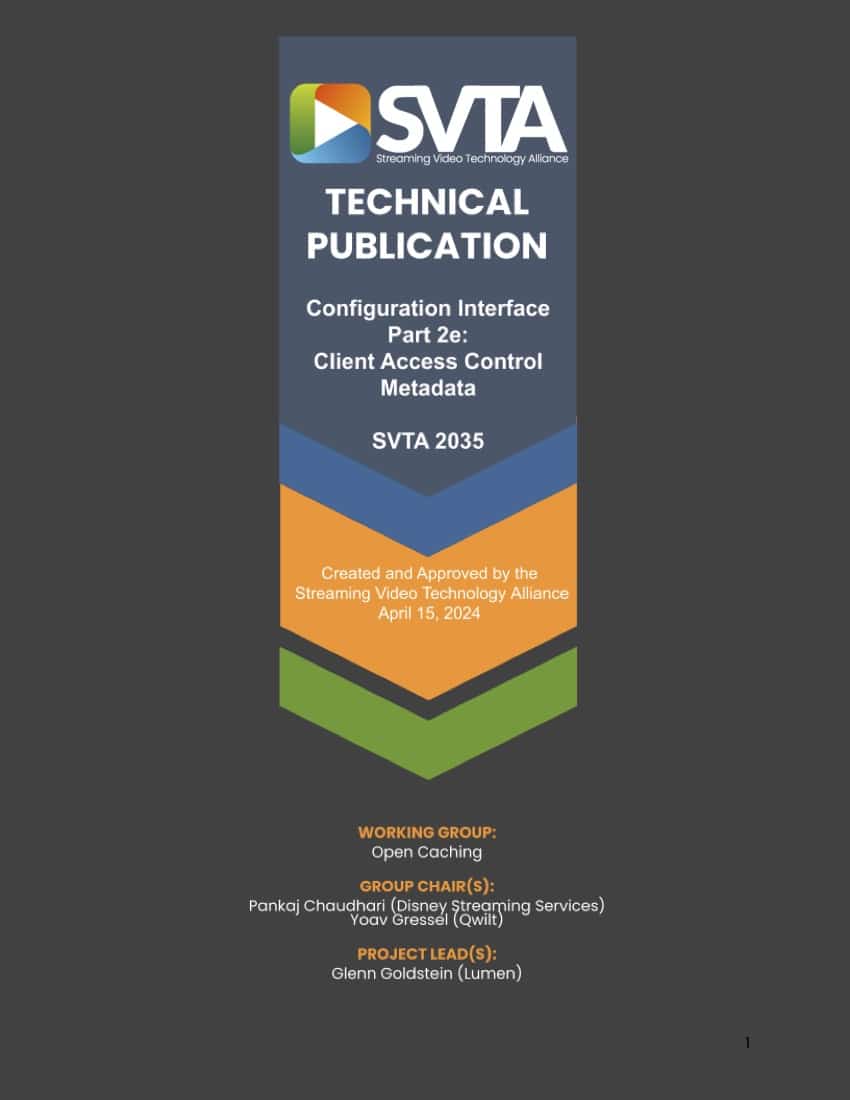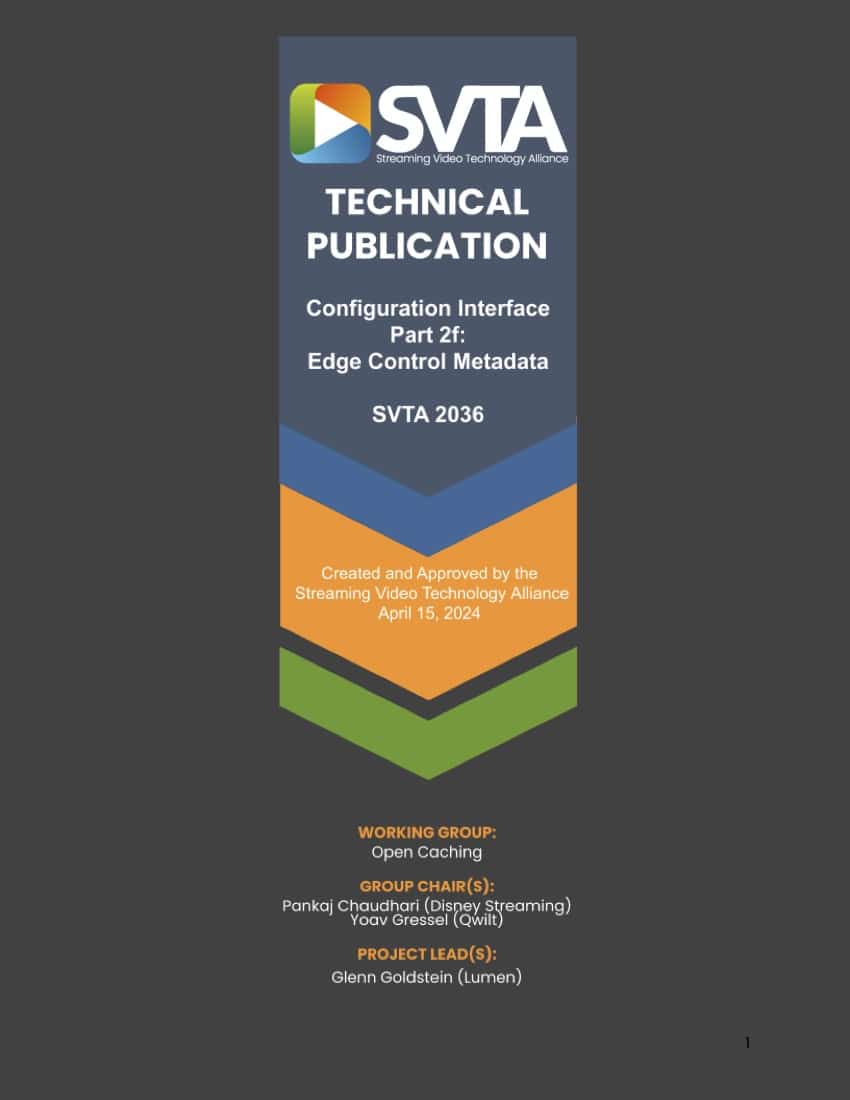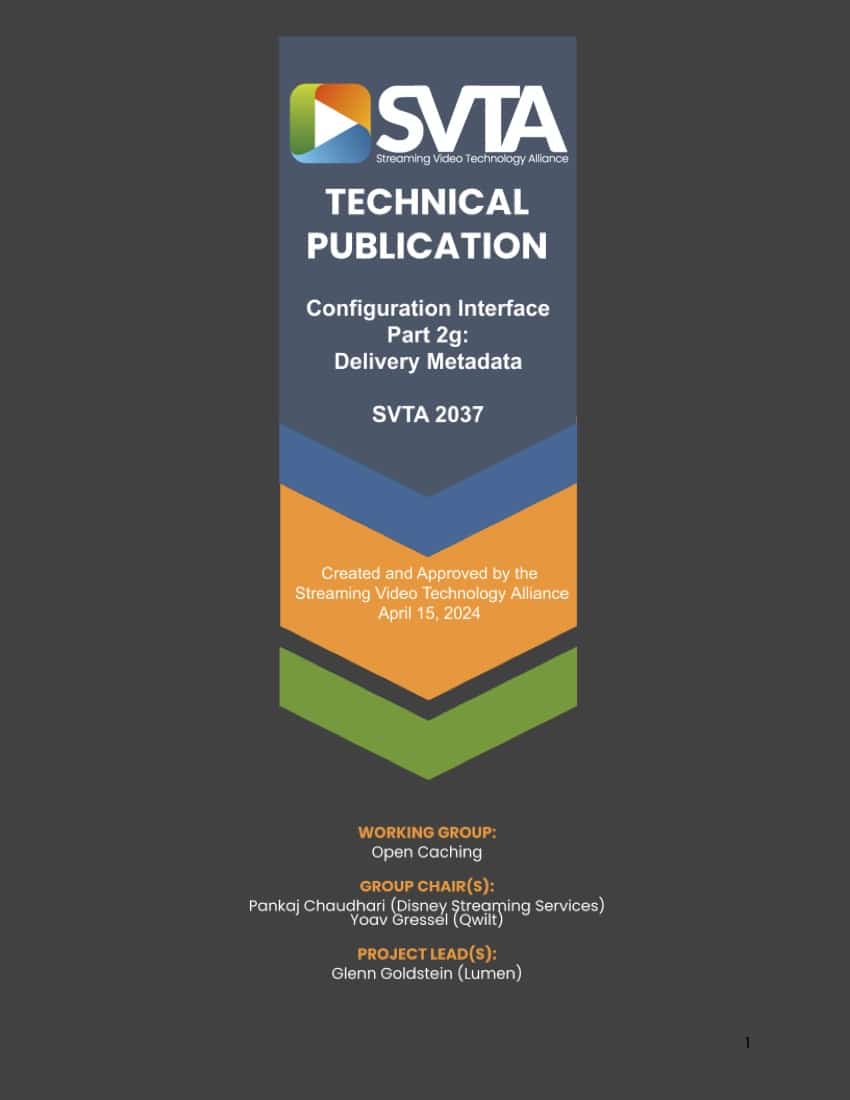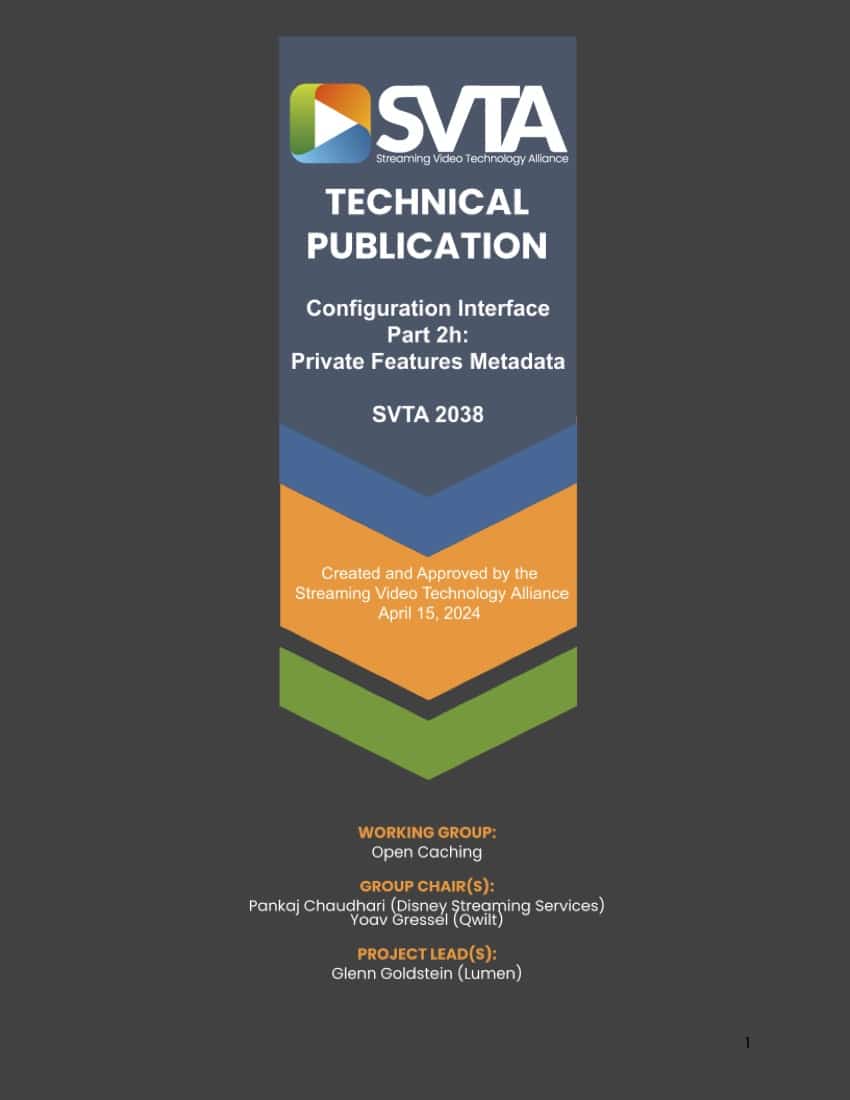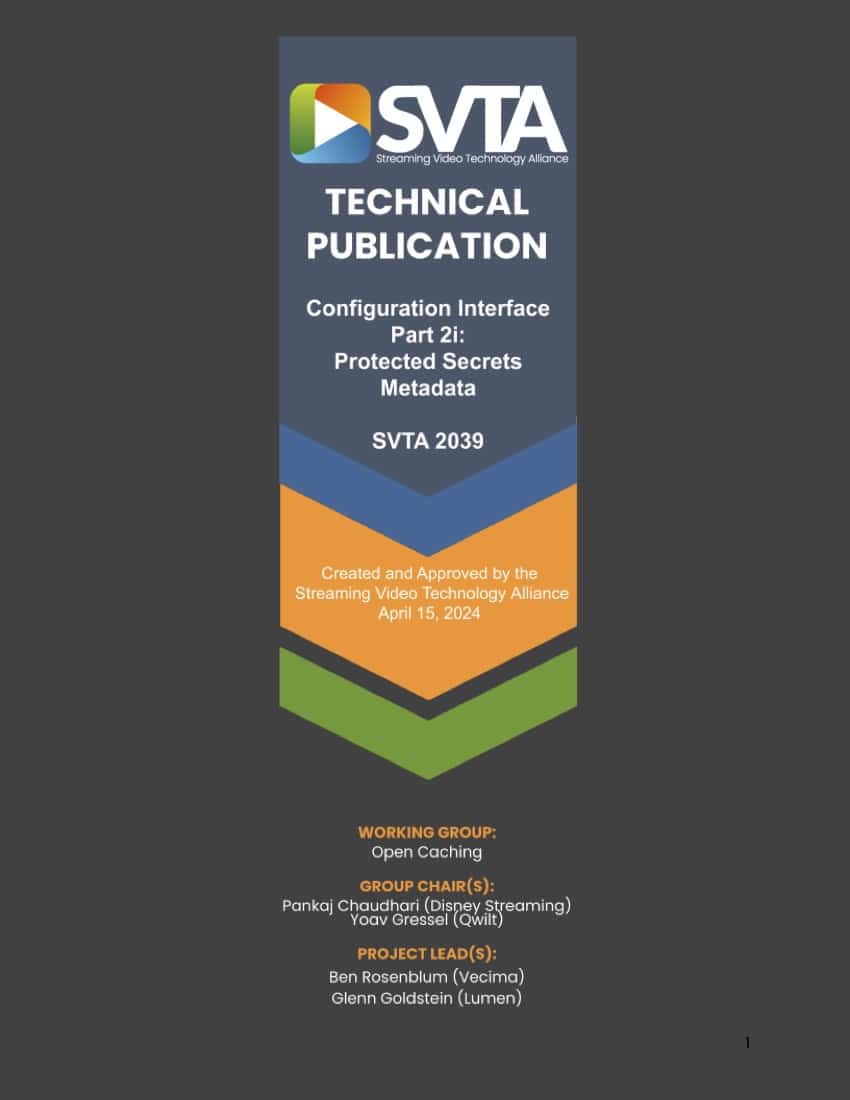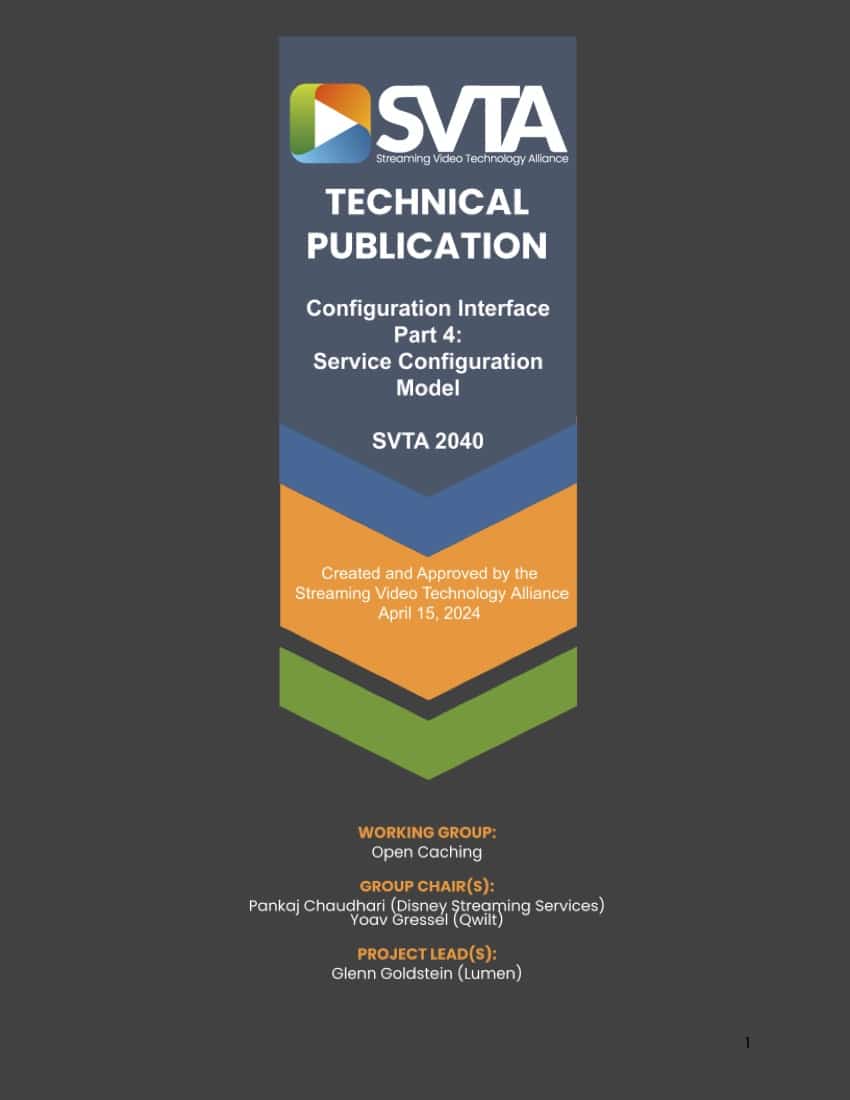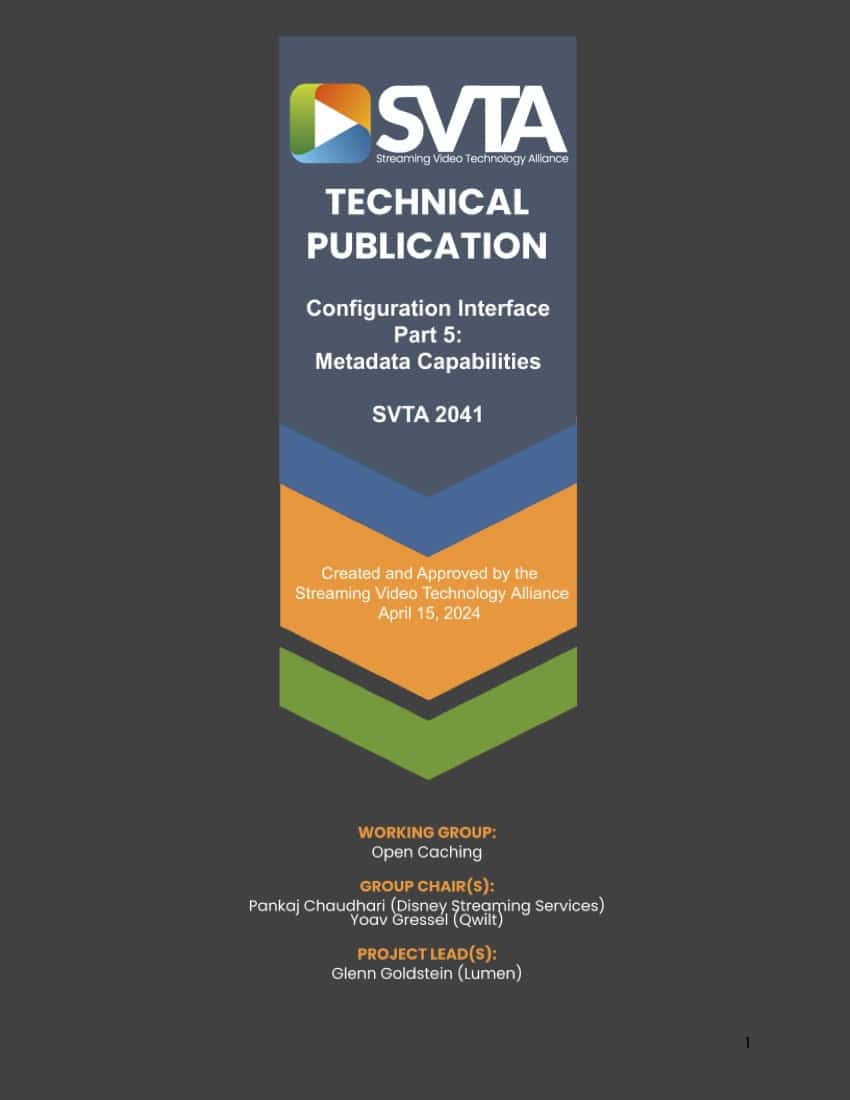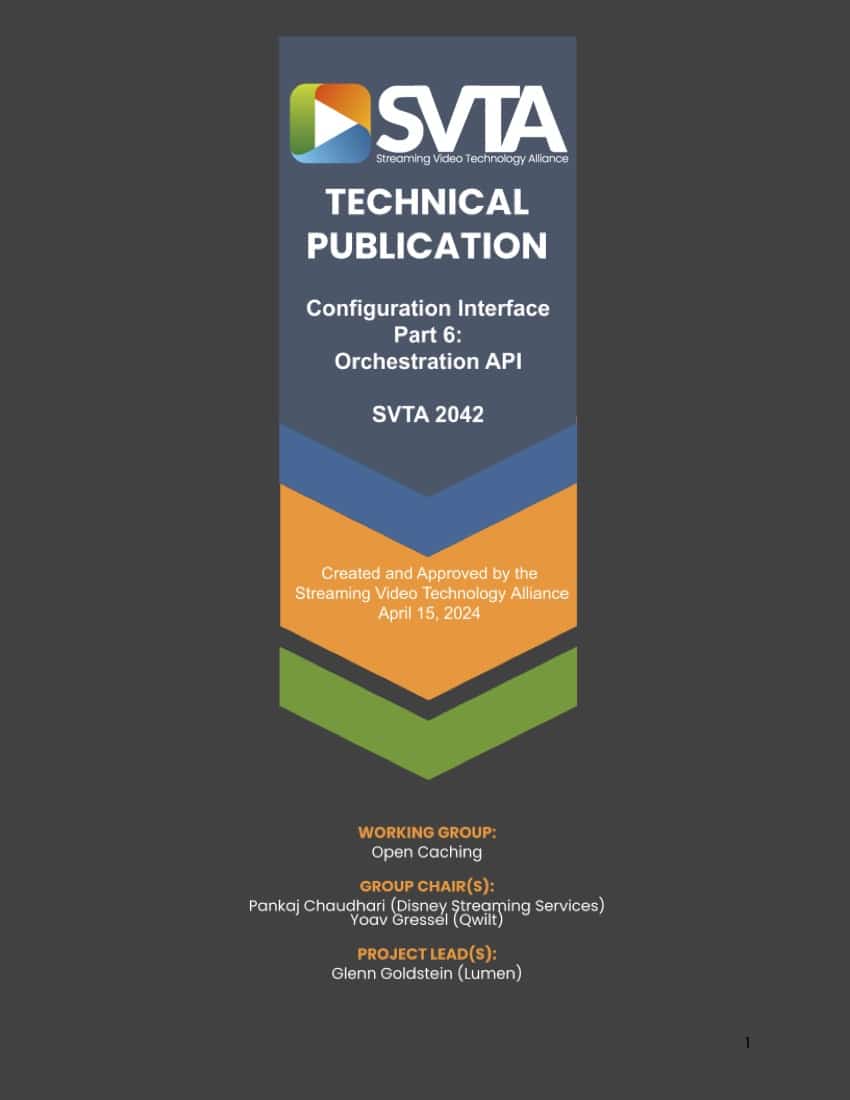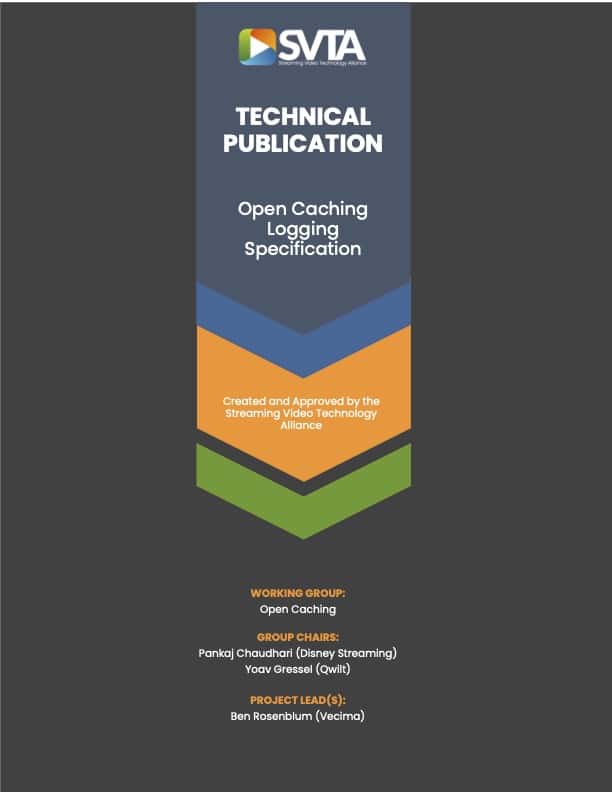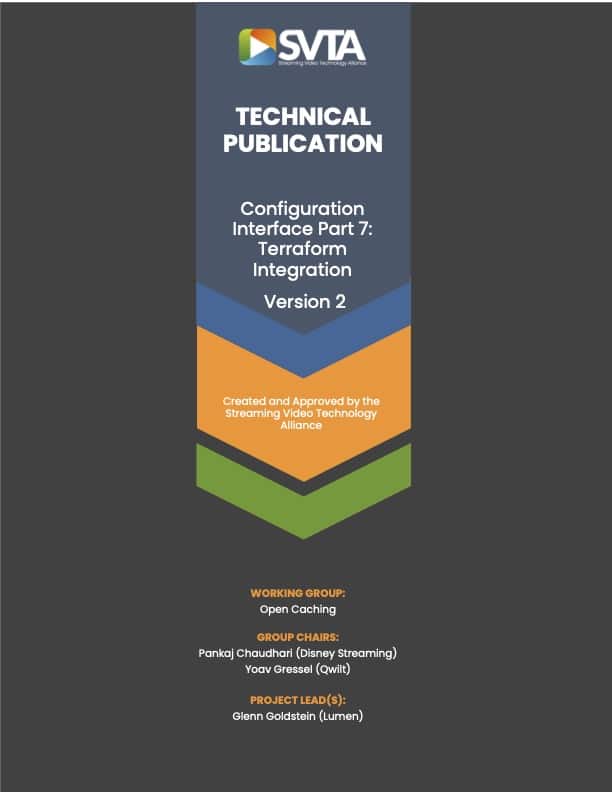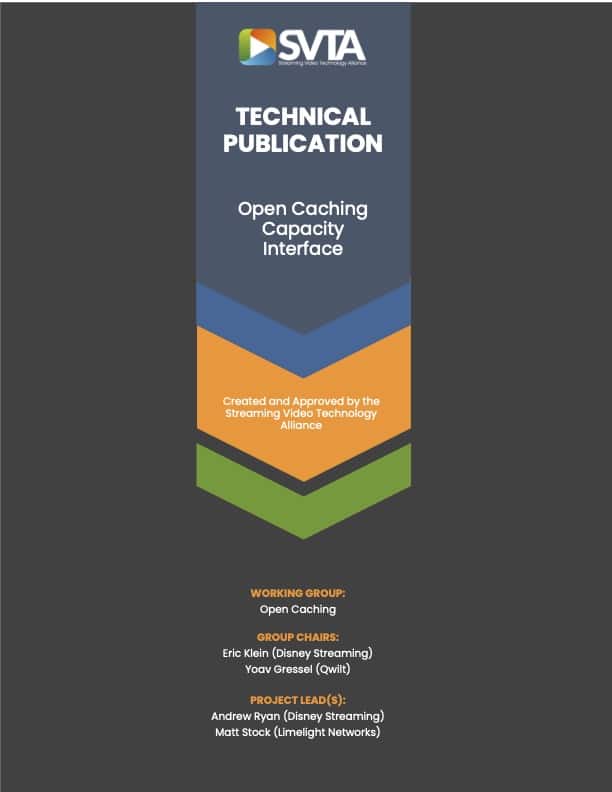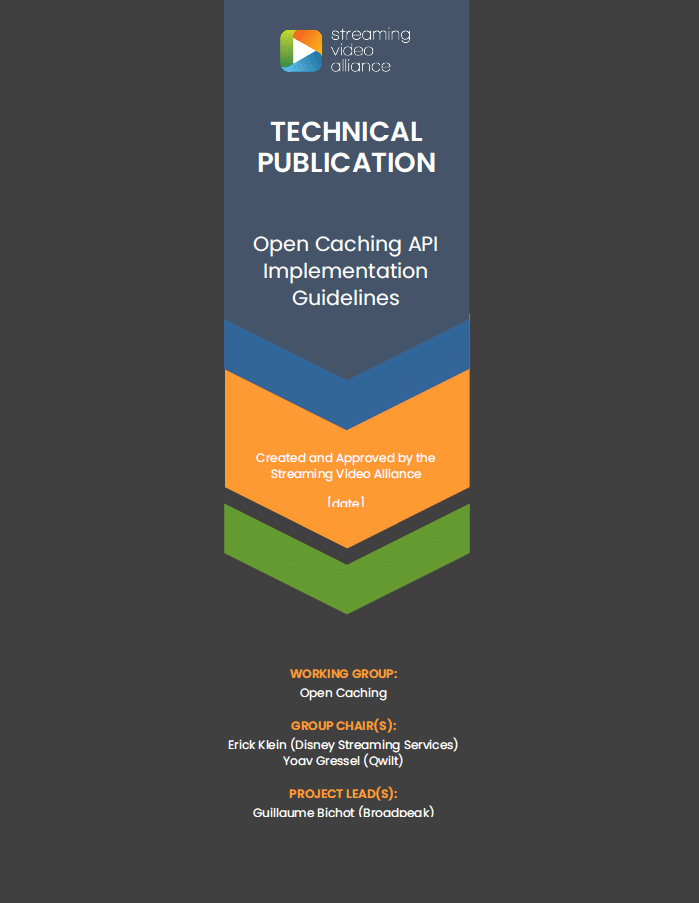Open Caching
- Home
- Open Caching
Overview
Objectives
Chairs
Technology Ambassador
Presentations
Below are presentations delivered during working group sessions. Click on the presentation name to open it (many files are for members only and will require authentication) and a presenter name to view their profile. Note: if a presenter’s profile is not public, it will redirect to their LinkedIn page.
Presented by Alan Arolovitch
Presented by Alfonso Siloniz
Presented by Andrew Ryan
Presented by Dan Newman
Presented by Glenn Goldstein
Presented by Guillaume Bichot
Presented by Pankaj Chaudhari
Presented by Yoav Gressel
Presented by Alfonso Siloniz
Presented by Guillaume Bichot
Presented by Alfonso Siloniz
Presented by Guillaume Bichot
Presented by Ben Rosenblum
Presented by Alfonso Siloniz
Presented by Alfonso Siloniz
Presented by Guillaume Bichot
Presented by Alfonso Siloniz
Presented by Guillaume Bichot
Documents
Published
SVTA1013: Optimizing Video Delivery With The Open Caching Network
Delivering a great video experience requires content to be served as close to the end-user as possible. In this whitepaper, we illustrate how network operators can implement Open Caching nodes at the edge of their network, while adhering to specifications created by the Open Caching Working Group of the Streaming Video Alliance. These nodes can mitigate delivery latency and provide an improved viewer experience when hosted by the ISP and connected to the CDN/Content Provider nodes outside of the operator network, to create an Open Caching Network.
SVTA2000: Open Cache Solution Functional Requirements Document
Problem statement and functional requirements of an open caching solution deployed by service providers to be used by content providers and content delivery networks.
SVTA2004: Open Cache Logging Requirements Specification
This document specifies requirements for Open Caching System (OCS) for Logging data to help track data acquisition and delivery of it to the end user. The information logging is critical for the Open Caching Nodes as well as the upstream CDN and the Content Provider (CP). Logging information helps OCS track key performance metrics such as, data acquisition, delivery success and failures, measuring of effective throughput, cache hits and for troubleshooting fault and performance degradation. The logging data provided to the CDN by the OCS is also used by CDNs for auditing, billing and SLA purposes. The information logging will also be used by Open Caching Nodes (making up an OCS) for ensuring its compliance of SLAs with CDNs and measuring and assuring Quality of Experience (QoE) for an end user.
SVTA2005: Open Caching Logging Integration Functional Specification
This document describes the process of provisioning a Logging Integration between a CDN and an ISP in an Open Caching solution. That is the process of configuring how delivery logs are transferred from ISP to CDN. The requirements for logging in Open Caching Nodes are described in the “Open Caching Logging Requirements Specification” document. This document defines extensions to the “Footprint and Capabilities” interface and to the “Service Metadata” interface, to allow provisioning a Logging Integration.
SVTA2006: Open Cache Request Routing Service Provisioning Interface Specification
This includes the functional specification of open-caching service provisioning interfaces enabling a CDN and an SP to exchange information to enable the delegation of CDN content requests to the SP Open Caching system.
SVTA2007: Open Cache Request Routing Functional Specification
This document describes the high-level functional specification of open caching request routing and the required interfaces to enable request routing to be performed from an upstream CDN to an open cache system. This version has been updated to address the Manifest Rewrite routing scheme.
SVTA2008: Open Caching Content Management Operations Specification
This document describes the functional specification of the Open Caching Content Management interface and the functionality requirements from the SP Open Caching system. This document discusses the interface between the SP Open Caching Controller and the CDN. The interface between the SP OCC and the cache nodes (OCNs) is beyond the scope of this document.
SVTA2016: Open Caching Relayed Token Authentication
This document describes the functional specification of open-caching relayed-token-authentication mechanism. The focus is on generically supporting URI signing using this method. There are additional applications – like user Cookies, which are mentioned in this document without getting into the specifics. While multiple different CDNs, as well as CDNi, support Tokenization in alternative methods, the goal of this implementation is to support all of these different formats via the relay authentication mechanism.
SVTA2018: Open Caching Performance Measurement Specification
This document outlines measurement metrics for open-caching. The focus of this document is to outline key performance indicators related to quality of service metrics at the open cache nodes that is responsible for delivering the streaming content.
SVTA2028: Open Caching Configuration Interface: Part 1: Overview and Architecture
This is the first part in a set of documents that specifies the motivational drivers, use cases, and standards for a configuration interface to facilitate interoperability within the content delivery network (CDN) and open caching ecosystems. This document set presents a layered architecture that extends the Internet Engineering Task Force (IETF) CDN Interconnect (CDNi) metadata model and adds publishing layer Application Programming Interfaces (APIs) to provide configuration management capabilities required by the CDN and open caching industries.
SVTA2029: Open Caching Configuration Interface: Part 2 – Extensions to CDNi Metadata Object Model
This is part two in a set of documents that specifies the motivational drivers, use cases, and standards for a configuration interface to facilitate interoperability within the content delivery network (CDN) and open caching ecosystem. This document presents the context and requirements for extending the Content Delivery Network Interconnection (CDNi) metadata model, as well as specific extensions that will fulfill those requirements.
This document will provide all the necessary information for an Internet Engineering Task Force (IETF) memo describing the Streaming Video Alliance (SVA) metadata interface requirements beyond those stated in RFC-7337 (Content Distribution Network Interconnection Requirements), along with requested extensions to RFC-8006 (Content Delivery Network Interconnection Metadata).
SVTA2030: Open Caching Configuration Interface: Part 3 – Publishing Layer APIs
This is part three in a set of documents that specifies the motivations, use cases, and standards for a configuration interface to facilitate interoperability within the content delivery network (CDN) and open caching ecosystems. In this document, the requirements for a configuration publishing layer are presented, along with APIs that facilitate the publishing of CDNi metadata objects within the CDN and open caching ecosystems.
SVTA2007-1: Open Cache Request Routing Functional Specification
This document describes the high-level functional specification of open caching request routing and the required interfaces to enable request routing to be performed from an upstream CDN to an open cache system. This is version 1 of the document.
SVTA2048: Open Caching API Request Routing Interface
Content delivery delegation in open caching can be realized through two modes of request redirection, iterative and recursive.
Open caching previously supported the iterative mode only. This document describes the data model and architecture changes required to enable the recursive mode of delegation as well.
SVTA2045: Open Caching API Footprint and Capabilities
This document describes the Application Programming Interface (API) methods and data model related to the Footprint and Capabilities Interface. The API has been entirely designed by the SVTA Open Caching group whereas the data model is based on the IETF Content Delivery Network Interconnection (CDNi) work. and on extensions specified by the SVTA Open Caching group.
SVTA2052: Configuration Interface Document Manifest Version 2.0
The SVTA Configuration Interface is a multi-part set of documents defining both the metadata model and Application Programming Interfaces (APIs) for entities to publish and retrieve configuration metadata for content caching and delivery.
This manifest specifies the SVTA document numbers and versions of each of the parts and subparts comprising a version of the Configuration Interface. Each individual document in the set is assigned a unique SVTA document number and is versioned independently. OpenAPI definitions as well as communications of compliance with this standard may make references such as Configuration Interface Version 2.0 or Configuration Interface Version 2.1. Those versions of this document manifest can be referenced to determine the SVTA document numbers and versions of the parts and subparts that comprise any given version of the Configuration Interface standard.
SVTA2028-1: Configuration Interface Part 1: Overview and Architecture
This is the first part in a set of documents that specify the Streaming Video Technology Alliance (SVTA) Configuration Interface, defining both the metadata model and Application Programming Interfaces (APIs) for entities to publish and retrieve configuration metadata. This document specifies the motivational drivers, use cases, and standards to facilitate interoperability within the content delivery network (CDN) and Open Caching ecosystems. The full document set presents a layered architecture that extends the Internet Engineering Task Force (IETF) CDN Interconnect (CDNI) Metadata and Capabilities Models and adds publishing APIs to provide configuration management capabilities required by the CDN and Open Caching industries.
SVTA2029-1: Configuration Interface Part 2: CDNI Metadata Model Extensions
The Internet Engineering Task Force (IETF) Content Delivery Networks Interconnection (CDNI) Metadata Interface enables interconnected content delivery networks (CDNs) to exchange content distribution metadata in order to enable content acquisition and delivery. This document and its subparts describe extensions to the CDNI Metadata Object Model as documented in “CDNI Metadata” [RFC8006] to address the complex requirements of the commercial CDN industry and to support a wider set of use cases such as Open Caching.
SVTA2030-1: Configuration Interface Part 3: Simple Configuration Metadata API
This is part 3 in a set of documents that specify the Streaming Video Technology Alliance (SVTA) Configuration Interface. This document presents the Simple Configuration Metadata API, which provides basic metadata retrieval and publishing capabilities, as introduced in SVTA Configuration Interface Part 1 Introduction & Architecture [SVTA2028].
SVTA2031: Configuration Interface Part 2a: Metadata Expression Language (MEL)
This document specifies the syntax and provides usage examples for an expression language to be used within Streaming Video Technology Alliance (SVTA)/Content Delivery Network Interconnection (CDNI) Metadata Interface (MI) objects. The purpose of this expression language is to enable metadata to be applied conditionally (based on aspects of an HTTP request), and to enable Hypertext Transfer Protocol (HTTP) responses to be generated or altered dynamically.
SVTA2032: Configuration Interface Part2b: Processing Stages Metadata
SVTA2033: Configuration Interface Part 2c: Cache Control Metadata
This specification adds to the basic cache control metadata defined in [RFC8006], providing content providers and upstream CDNs (uCDNs) more fine-grained control over downstream CDN (dCDN) caching. Use cases include overriding or adjusting cache control headers from the origin, bypassing caching altogether, or altering cache keys with dynamically generated values.
SVTA2034: Configuration Interface Part 2d: Source Access Control Metadata
This specification provides an alternative to the MI.SourceMetadata objects defined in [RFC8006], providing greatly extended capabilities with regards to defining multiple sources, load balancing, and failover rules across those sources, as well as a mechanism for a content delivery network (CDN) to monitor source health and pull unhealthy sources out of rotation. Additionally, new methods are defined for authentication access to an upstream source/origin.
SVTA2035: Configuration Interface Part 2e: Client Access Control Metadata
This specification adds to the basic client access control metadata in [RFC8006], providing content providers and upstream content delivery networks (uCDNs) extended capabilities in defining location and time window restrictions. Support is also provided to define required Transport Layer Security (TLS) certificates and encryption levels.
SVTA2036: Configuration Interface Part 2f: Edge Control Metadata
This specification defines configuration metadata objects related to controlling edge access to resources via content delivery networks (CDNs) and Open Caching systems. Configuring Cross-Origin Resource Sharing (CORS) access rules and the dynamic generation of CORS headers is a key feature of typical configurations, as are the ability to define response body compression rules and client connection timeouts.
SVTA2037: Configuration Interface Part 2g: Delivery Metadata
This specification adds to the core set of configuration metadata defined in [RFC8006], providing delivery metadata to define traffic types, Open Caching request delegation behavior for Open Caching node selection, and request routing modes of traffic delegation.
SVTA2038: Configuration Interface Part 2h: Private Features Metadata
This specification defines a mechanism for downstream content delivery networks (dCDNs) to define private extensions to the metadata model that are mutually agreed upon between participating upstream content delivery networks (uCDNs) and dCDNs.
SVTA2039: Configuration Interface Part2i: Protected Secrets Metadata
This document defines a simple mechanism for protected secret data (such as salt values or encryption keys) that may be embedded in configuration metadata or capabilities advertisements.
SVTA2040: Configuration Interface Part 4: Service Configuration Model
This specification introduces the Service Configuration Model, an object layer that wraps the HostMatch metadata defined in [RFC8006] with a construct defining content delivery network (CDN) Services and Properties (groups of hosts with shared metadata definitions), as well as reusable metadata definitions that can be used across all of a service’s CDN Properties. The Service Configuration Model represents a self-contained bundle of configuration metadata and definitions that can be published and deployed as an atomic unit without external references. This model is defined independently of any Application Programming Interface (API) and will be used as the basis for the Streaming Video Technology Alliance (SVTA) Orchestration API.
SVTA2041: Configuration Interface Part 5: Metadata Capabilities
This document defines the requirements and model for a CDNI Footprint & Capabilities (FCI) object that allows a downstream content delivery network (dCDN) to advertise the configuration metadata capabilities that it supports. It goes beyond the simple FCI.Metadata object defined in [RFC80008] by providing fine-grained advertisements with allowed usage contexts and allowed values as well as advertisements for specific Metadata Expression Language (MEL) capabilities.
SVTA2042: Configuration Interface Part 6: Orchestration API
The Orchestration API provides full configuration metadata lifecycle management, with publishing and staged deployment as distinct operations, along with versioning and rollback capabilities. The API provides capabilities required by infrastructure orchestration tools such as Terraform and Ansible to issue the commands necessary to update a dCDN configuration to a desired state.
Draft
Note that to download draft documents, you must be an employee of an active member company with an ARO account. If you are part of a member company and don’t yet have an ARO account, you can request one here.
SVTA2029-1: Configuration Interface Part 2: CDNI Metadata Model Extensions
The Internet Engineering Task Force (IETF) Content Delivery Networks Interconnection (CDNI) Metadata Interface enables interconnected content delivery networks (CDNs) to exchange content distribution metadata in order to enable content acquisition and delivery. This document and its subparts describe extensions to the CDNI Metadata Object Model as documented in “CDNI Metadata” [RFC8006] to address the complex requirements of the commercial CDN industry and to support a wider set of use cases such as Open Caching.
SVTA2052: Configuration Interface: Document Manifest Version 2.0
The SVTA Configuration Interface is a multi-part set of documents defining both the metadata model and Application Programming Interfaces (APIs) for entities to publish and retrieve configuration metadata for content caching and delivery.
This manifest specifies the SVTA document numbers and versions of each of the parts and subparts comprising a version of the Configuration Interface. Each individual document in the set is assigned a unique SVTA document number and is versioned independently. OpenAPI definitions as well as communications of compliance with this standard may make references such as Configuration Interface Version 2.0 or Configuration Interface Version 2.1. Those versions of this document manifest can be referenced to determine the SVTA document numbers and versions of the parts and subparts that comprise any given version of the Configuration Interface standard.
Participating Companies




























